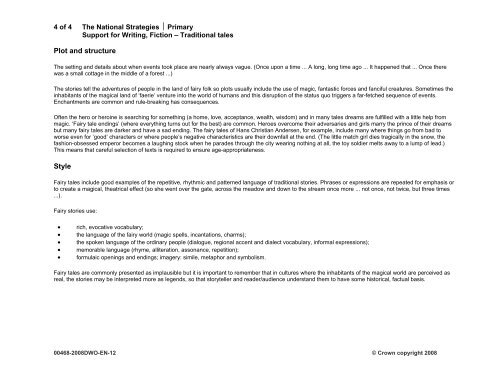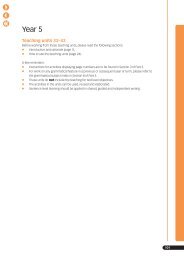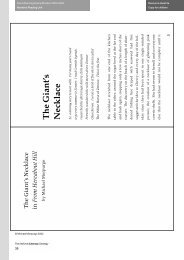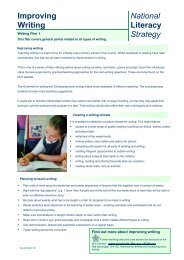Narrative – Traditional tales – Fairy tales
Narrative - Traditional tales - Fairy tales - School-Portal.co.uk
Narrative - Traditional tales - Fairy tales - School-Portal.co.uk
- No tags were found...
Create successful ePaper yourself
Turn your PDF publications into a flip-book with our unique Google optimized e-Paper software.
4 of 4 The National Strategies ⏐ PrimarySupport for Writing, Fiction <strong>–</strong> <strong>Traditional</strong> <strong>tales</strong>Plot and structureThe setting and details about when events took place are nearly always vague. (Once upon a time ... A long, long time ago ... It happened that ... Once therewas a small cottage in the middle of a forest ...)The stories tell the adventures of people in the land of fairy folk so plots usually include the use of magic, fantastic forces and fanciful creatures. Sometimes theinhabitants of the magical land of ‘faerie’ venture into the world of humans and this disruption of the status quo triggers a far-fetched sequence of events.Enchantments are common and rule-breaking has consequences.Often the hero or heroine is searching for something (a home, love, acceptance, wealth, wisdom) and in many <strong>tales</strong> dreams are fulfilled with a little help frommagic. ‘<strong>Fairy</strong> tale endings’ (where everything turns out for the best) are common. Heroes overcome their adversaries and girls marry the prince of their dreamsbut many fairy <strong>tales</strong> are darker and have a sad ending. The fairy <strong>tales</strong> of Hans Christian Andersen, for example, include many where things go from bad toworse even for ‘good’ characters or where people’s negative characteristics are their downfall at the end. (The little match girl dies tragically in the snow, thefashion-obsessed emperor becomes a laughing stock when he parades through the city wearing nothing at all, the toy soldier melts away to a lump of lead.)This means that careful selection of texts is required to ensure age-appropriateness.Style<strong>Fairy</strong> <strong>tales</strong> include good examples of the repetitive, rhythmic and patterned language of traditional stories. Phrases or expressions are repeated for emphasis orto create a magical, theatrical effect (so she went over the gate, across the meadow and down to the stream once more ... not once, not twice, but three times...).<strong>Fairy</strong> stories use:• rich, evocative vocabulary;• the language of the fairy world (magic spells, incantations, charms);• the spoken language of the ordinary people (dialogue, regional accent and dialect vocabulary, informal expressions);• memorable language (rhyme, alliteration, assonance, repetition);• formulaic openings and endings; imagery: simile, metaphor and symbolism.<strong>Fairy</strong> <strong>tales</strong> are commonly presented as implausible but it is important to remember that in cultures where the inhabitants of the magical world are perceived asreal, the stories may be interpreted more as legends, so that storyteller and reader/audience understand them to have some historical, factual basis.00468-2008DWO-EN-12 © Crown copyright 2008








